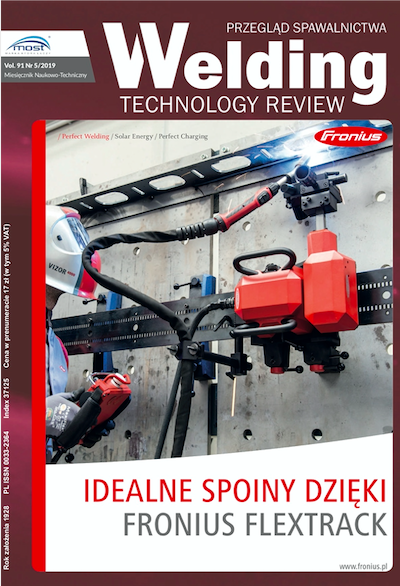The influence of the carbon equivalent on the weldability of high-strength low-alloy steel in the water environment
##plugins.themes.bootstrap3.article.main##
Abstrakt
From many years, the high strength low alloy steels are often used for offshore constructions. This constructions, due to the environment in which they work, require more frequent repairs than the constructions from the land. For economic reasons, repairs take place in the underwater conditions, however water significantly decreases the weldability of steel. The paper presents the results of the CTS weldability test for S460ML and S460 steels, which have a similar value of the yield point, but different carbon equivalent (CeMIS) values. The welded joints were cut into specimens, which were then subjected to Vickers HV10 hardness measurements. The experiment has shown that as the CeMIS value increases, the hardness in the heat affected zone (HAZ) of joints and in the weld metal increases.
Pobrania
##plugins.themes.bootstrap3.article.details##
Creative Commons CC BY 4.0 https://creativecommons.org/licenses/by/4.0/
Artykuły czasopisma Welding Technology Review (Przegląd Spawalnictwa) publikowane są w otwartym dostępie na licencji CC BY (licencja Creative Commons Uznanie autorstwa 4.0 Międzynarodowe). Licencja CC BY jest najbardziej otwartą dostępną licencją i uważaną za „złoty standard” w formule otwartego dostępu; jest również preferowany przez wielu fundatorów badań. Licencja ta umożliwia czytelnikom kopiowanie i redystrybucję materiału na dowolnym nośniku i w dowolnym formacie, a także zmienianie, przekształcanie lub budowanie na nim materiału, w tym do użytku komercyjnego, pod warunkiem wskazania oryginalnego autora.
Bibliografia
Qiang X., F. Bijlaard F., Kolstein H. Elevated-temperature mechanical properties of high strength structural steel S460N: Experimental study and recommendations for fire-resistance design. Fire Safety Journal, 2013, Vol. 55, 15- 21. DOI: https://doi.org/10.1016/j.firesaf.2012.10.008
Omajane J., Martikainen J., Kah P. Weldability of thermo-mechanically rolled steels used in oil and gas offshore structures. The International Journal of Engineering and Science, 2014, Vol. 3(5), 62-69.
Skowrońska B., Szulc J., Chmielewski T., Sałaciński T., Swiercz R. Properties and microstructure of hybrid Plasma+MAG welded joints of thermomechanically treated S700MC steel. 27th Anniversary International Conference on Metallurgy and Materials (METAL) 2018, Brno, Czech Republic.
Górka J. Assessment of steel subjected to thermomechanical control process with respect to weldability. Metals, 2018, Vol. 3(3), 169. DOI: https://doi.org/10.3390/met8030169
Tomków J., Janeczek A. The influence of welding environment on the properties of Tekken joints made from S355J2C+N steel. Welding Technology Review, 2019, Vol. 91(1), 15-19. DOI: https://doi.org/10.26628/wtr.v91i1.997
Tomków J., Łabanowski J., Fydrych D., Rogalski G. Cold cracking of S460N steel in water environment. Polish Maritime Research, 2018, Vol. 3(99), 131-136. DOI: https://doi.org/10.2478/pomr-2018-0104
Tomków J., Rogalski G., Fydrych D., Łabanowski J. Improvement of S355G1+N steel weldability in water environment by Temper Bead Welding. Journal of Materials Processing Technology, 2018, Vol. 262, 372-381. DOI: https://doi.org/10.1016/j.jmatprotec.2018.06.034
Tomków J., Rogalski G., Fydrych D., Łabanowski J. Advantages of the application of the temper bead welding technique during wet welding. Metals, 2019, Vol. 12(6), 915. DOI: https://doi.org/10.3390/ma12060915
Tomków J., Rogalski G., Fydrych D., Łabanowski J., Weldability testing of S460N steel in water environmental by using tekken. Welding Technology Review, 2018, Vol. 90(5), 41-45. [CrossRef] DOI: https://doi.org/10.26628/ps.v90i5.895
Padilla E., Chawla N., Silva L.F., dos Santos V.R., Paciornik S., Image analysis of cracks in the weld metal of a wet welded steel joint by threedimensional (3D) X-ray microtomography. Materials Characterization, 2013, Vol. 83, 139-144. DOI: https://doi.org/10.1016/j.matchar.2013.06.016
Guo N., Yang Z., Wang M., Yuan X., Feng J., Microstructure and mechanical properties of an underwater wet welded dissimilar ferritic/austenitic steel joint. Strength of Materials, 2018, Vol. 47(1), 12-18. DOI: https://doi.org/10.1007/s11223-015-9622-6
Schaupp T., Rhode M., Yahyaoui H., Kannengiesser T., Influence of heat control on hydrogen distribution in high-strength multi-layer welds with narrov groove. Welding in the World, 2018, 1-10. DOI: https://doi.org/10.1007/s40194-018-00682-0
Wang J., Sun Q., Wu L., Liu L., Teng J., Feng J., Effect of ultrasonic vibration on microstructural evolution and mechanical properties of underwater wet welding joint. Journal of Materials Processing Technology, 2017, Vol. 246, 185-197. DOI: https://doi.org/10.1016/j.jmatprotec.2017.03.019
Wang J., Sun Q., Zhang S., Wang C., Wu L., Feng J., Characterization of the underwater welding arc bubble through a visual sensing method. Journal of Materials Processing Technology, 2018, Vol. 251, 96-108. DOI: https://doi.org/10.1016/j.jmatprotec.2017.08.019
Gao W.B., Wang D., Cheng F., Di X., Xu W., Mictostructural and mechanical performance of underwater wet welded S355 steel. Journal of Materials Processing Technolony, 2016, Vol. 238, 333-34. DOI: https://doi.org/10.1016/j.jmatprotec.2016.07.039
Gao W.B., Wang D., Cheng D., Deng C., Xu W. Underwater wet welding for HSLA steels: chemical composition, defects, microstructures, and mechanical properties. Acta Metallurgica Sinica (English Letters), 2015, Vol. 9, 1097-1108. DOI: https://doi.org/10.1007/s40195-015-0300-2
Products catalog Omnia of Lincoln Electic.
Fydrych D., Rogalski G., Łabanowski J., Problems of underwater welding of higher-strength low alloy steels. Institute of Welding Bulletin 2014, Vol. 5, 187-195.
